#LegacySystemModernization
Explore tagged Tumblr posts
Text
Struggling with digital transformation? Learn how to tackle top challenges—resistance, legacy systems & more. Stark Digital Media helps you succeed.
#digitaltransformation#legacysystemmodernization#digitaltransformationstrategy#digitaltransformationROI#digitaltransformationCompany#digitaltransformationService#cybersecurityindigitaltransformation#digitaltransformationChallenges#digitaltransformationinitiatives
0 notes
Text

#AIAgents#LegacySystemModernization#DigitalTransformation#Automation#AIinCanada#IntelligentAutomation#EnterpriseAI#WorkflowAutomation#AIIntegration#ProphecyTechnologies
0 notes
Text
We specialize in platform & product modernization, helping businesses upgrade legacy systems with the latest technologies. Our solutions enhance performance, scalability, and user experience, ensuring your platforms and products stay competitive in a digital-first world.
#Platform&ProductModernization#LegacySystemModernization#LegacySystemIntegration#TechUpgrades#TechSolutions
0 notes
Text
A Survey of Legacy System Modernization Approaches
Is your business stuck with outdated infrastructure? Re-Engineering allows you to migrate existing systems to the cloud with minimal disruption and code changes. Considering Legacy System Modernization approach offers a fast and efficient transition, letting you enjoy the benefits of cloud scalability, flexibility, and integration without a complete overhaul. Transform your operations and unlock new potential with re-platforming. Learn more about how this approach can streamline your business processes!
Read full article here - https://www.iprogrammer.com/a-survey-of-legacy-system-modernization-approaches/
#legacysystemmodernization#legacyapplicationmodernization#legacyappmodernization#legacysoftwaremodernization#legacysystemmodernizationapproaches#mainframelegacymodernization#legacysystemmigrationstrategy#legacyapplicationmodernisation#legacymodernizationservices#legacysystemmodernisation#legacymodernizationstrategy#legacyapplicationmodernizationsolution#legacyitmodernization
0 notes
Text
Increase Productivity with TechPanda IT Services' Custom Software Solutions
Use TechPanda IT Services to improve client interaction and business processes. Custom software development, enterprise software solutions, and legacy system modernisation are among our areas of expertise. While our software product development services assist in bringing cutting-edge items to market, our bespoke CRM development helps you manage client connections efficiently. Furthermore, you can keep ahead of the competition in a cutthroat industry by using our Data Analytics & Information Services to glean insightful information from your data.#EnterpriseSoftware #CRMDevelopment #SoftwareProductDevelopment #DataAnalytics #BusinessOptimization #TechInnovation #CustomSoftware #TechPandaIT #SoftwareDevelopment #LegacySystemModernization
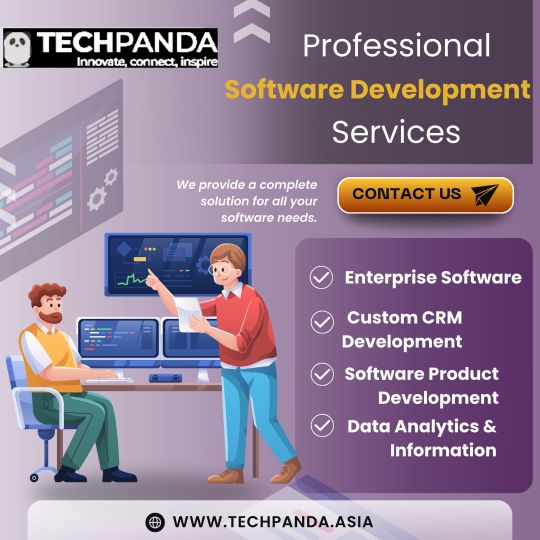
0 notes
Text
Legacy System Modernization: How to Transform the Enterprise for Digital Future
Legacy system modernization can help you keep up with digital transformation goals. Many organizations have a large amount of code that’s decades old. And as time goes on, these applications become less and less efficient. They are no longer in sync with current needs and industry standards.
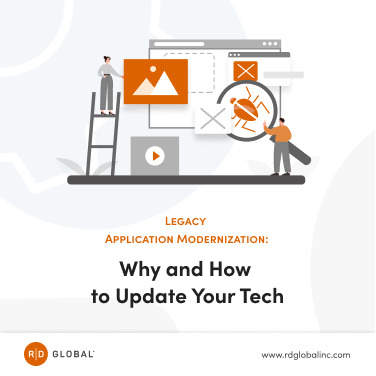
Our latest blog post, available at https://www.rdglobalinc.com/legacy-application-modernization-why-and-how-to-update-your-tech/, provides a comprehensive overview of why and how to update your tech to improve performance.
To determine if your application requires modernization, fill out the below form at https://www.rdglobalinc.com/contact/ for a complimentary consultation.
#rdglobalinc#legacysoftwaremodernizationcompany#legacysoftwaremodernizationservices#legacysystem#legacymodernization#legacysystemmodernization
0 notes
Text
How Application Modernization Can Transform Your Business
In today's digital world, many businesses still depend on outdated software systems to run daily operations. While these systems may have worked well in the past, they now slow down growth and innovation. As a result, businesses now count on legacy system modernization services to keep up with the competition.
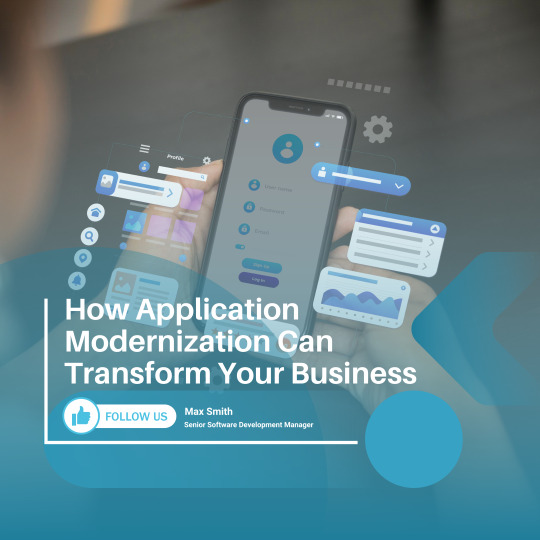
The Real Cost of Legacy Systems
Running old systems costs more than just money. According to IDC, companies spend 60–80% of their IT budgets just to keep legacy systems running. These systems also increase downtime, make integration harder, and raise security risks.
A report from Accenture showed that more than half of businesses (54%) say legacy systems stop them from launching new digital projects. This prevents companies from growing and from adapting fast to any changes in the market.
Key Business Benefits of Application Modernization
Modernizing legacy systems results in better performance for the complete business.
Here are the Key benefits of legacy system modernization:
1. Better Efficiency
Modern systems are designed to do routine tasks automatically, minimize mistakes and make processes faster. When a business adopts modern systems, it can speed up processes and achieve more goals with less work.
2. Stronger Security and Compliance
Legacy system modernization is harder to protect. Modern systems come with built-in security features and are easier to keep up to date with current laws and regulations such as GDPR & HIPAA. This approach helps lessen the possibility of experiencing a data breach and paying fines.
3. Scalability for Growth
Modern applications can grow with your business. Whether your company is expanding or facing high demand, these systems can handle the changes without needing major upgrades.
4. Better Customer Experience
A faster system speeds up the way services are delivered. Better user experiences and higher satisfaction with the service result from a faster experience and modern look.
5. Improved Use of Data
Legacy systems often don't support real-time data sharing. Modern systems make it easy to analyze data and support more intelligent decision-making across departments.
How Modernization Happens
There are a few common ways to modernize:
Rehosting (moving systems to the cloud)
Re-platforming (changing the base platform)
Rearchitecting (rebuilding core systems)
Replacing (starting from scratch)
The right approach depends on your current setup and business needs. Cloud migration plays a big part in many modernization strategies. Gartner forecasts that by 2026, 75% of companies will rely on cloud-based modernization to compete effectively.
Trusted Providers of Legacy System Modernization Services
Choosing the right partner is key. A good provider ensures smooth migration, minimal risk, and real value. Some companies known for offering reliable legacy system modernization services include Suma Soft, Capgemini, Infosys, and Wipro.
Making your applications modern is a business and IT choice that leads to lasting results. Modern IT systems give organizations an advantage and help them handle future problems or advantages.
1 note
·
View note
Text
A Survey of Legacy System Modernization Approaches
Ever since the tech-savvy market expects digital-first businesses, the newer advancements have made companies re-evaluate their strategies. Technology, is being taken seriously, with companies adopting the new gen ways of functioning.
Similarly, legacy systems are being taken over with new approaches & new strategies to upgrade them once they reach their limits.
As we explore innovative ways, like social media metrics, mobile apps, data-based insights, AI/ML- relying on rigid infrastructures is an obstacle.
This is the time for companies to act. By leveraging modern tools & technologies, companies can access new opportunities, streamline core processes & achieve greater business goals through scalability.
What are Legacy Systems?
Legacy systems, the aging infrastructure systems we know about, lose their ability to serve the business once termed as ‘legacy’. These systems are built using tightly coupled technology, often running on software & hardware that companies own, manage, and support.
Thus, they’re built around a specific company’s investments, and working.
While being functional, these systems can affect your systems severely. Here’s why:
1. Maintenance Load
Legacy systems can be expensive to maintain, with higher possibilities of vendor lock-in traps.
2. Innovation Roadblock
The right structure, the way they are built on right infrastructure, hinders one’s ability to adapt the systems & leveraging new technologies to sustain innovation.
The bottom line is that legacy systems have a higher potential of going against the highly evolving markets. Companies must analyze & explore different approaches to tackle this new challenge.
What is
Legacy System Modernization
Legacy system modernization is a process of updating & optimizing the current legacy systems to meet current business needs. The approach of modernizing these systems would certainly differ between companies.
However, with the rise of new systems & technologies, companies are feeling the pressure to adapt to new changes, needs and advancements.
Here’s a brief in the ways legacy system modernization benefits the business:
1. Boosts Efficiency
Modernizing legacy systems can help streamline core processes, making it to be smoother and faster.
2. Using New Technologies
Through legacy system modernization, businesses leverage the possibilities of cutting-edge technologies that bring forth innovation & improve customer stakes.
3. Seamless Integration
Systems that have been modernized can easily connect & share data with other technologies, making the systems more unified.
Modernizing Legacy Systems
Often, businesses are stuck with outdated systems which disrupt & the fear of upgrading these systems. Businesses must outright acknowledge the issues these systems can bring forth.
The reality still stands that clinging to these old systems will leave companies vulnerable, owing to the security risks, undermined efficiency & limited ability to make accurate analyses.
The process of legacy system modernization has evolved beyond just updating when required. Now, it pays attention to the unique digital requirements of businesses.
This allows businesses an added layer of consideration while choosing from multiple approaches. Businesses can avail:
1. Strengthened Core Processes
Upgraded IT infrastructure & functionalities to establish a stronger foundation.
2. Innovation
Integrated newer technologies & functionalities to facilitate new possibilities.
3. Enhanced Customer Experience
Additional benefits of developing deep customer relationships to provide exceptional service.
Now, we understand how legacy system modernization is changing with newer technologies, let’s try to explore the different modernization approaches now!
Legacy System Modernization Approaches
A. Re-platforming, or re-hosting
This powerful modernization approach lets companies migrate their existing systems who a cloud-based ecosystem without expansive code changes.
Think of it like rearranging the furniture around the house.
Here’s why this approach is popular:
1. Fast & efficient processes This approach allows the modernization process to have as little disruption as possible on other systems. This is because it takes much less time to employ this approach.
2. Cloud Benefits Delivered This approach lets businesses reap the benefits of cloud computing: scalability, expansion & seamless integration. These benefits can be availed without even a complete system overhaul.
3. Reduced Reliance on Hardware Such an approach lets every system capture a space in the World Wide Web. This allows businesses to let go of expensive & unmaintainable systems, making room for additional flexibility.
Although there exist some minor code changes or database modifications here & there, the approach offers a smooth transition of multiple applications.
B. Rewrite
This approach includes developers rewriting the existing legacy code & building it anew. This process has two ways to function: manual & automated.
Manual efforts let dedicated developers offer complete control over the new system. However, it can take a significant time frame to achieve the required results.
Now, there exist automated tools to rewrite the code, accelerating the entire process.
Regardless of the path chosen, rewriting offers a fresh start for companies to break free of the tried & tested moulds.
C. Replacing with Ready-Made Solutions
For many companies, directly replacing legacy systems with commercial solutions can be implemented effectively.
These off-the-rack solutions let businesses avail themselves of pre-built functionalities & workflows that integrate smoothly with current systems.
Such solutions carry readily available features, security updates & compliance capabilities. Additionally, it lets companies to future-proof their systems with the use of newer technologies.
D. Retaining the Current System
Even when completely modernizing a legacy system is preferable, let’s explore an approach where the companies tend to retain them.
This happens due to:
1. Systems being a perfect fit Current systems are built for delivering the exact functionality a business needs.
2. User Comfort Many stakeholders, such as all the employees, including the C-suite level associates, are already comfortable using a set system.
3. Complexities in Integration Choosing a complete overhaul while modernizing legacy systems disrupts the ongoing integrations with existing processes.
4. Limited Use This refers to when the legacy system is only utilized whilst auditing or any compliance related reasons.
In a case like this, companies have the options to archive the system for a low-cost solution or customize it heavily to just generate reports from it.
E. Using DevOps for Legacy
Many businesses have started relying on a DevOps solution to facilitate the process of legacy system modernization. This lets businesses constantly integrate new or updated code into a single codebase.
This results in streamlined processes to build & deploy error-free code later and faster.
However, employing this solution require 3 prerequisites to be set up:
– A unified development landscape
– A single repository for all code
– Automated Testing
Having the DevOps approach allows the implementation of any changes to be done in shorter cycles, making room for agility.
F. Data Modernization for Legacy Systems
The high costs included in managing legacy systems are trumped by the costs & efforts it takes to handle all the big data businesses receive.
This heavily hinders a business’s ability to integrate new gen tech like cloud computing, big data & mobile applications.
Some businesses, thus, choose to migrate their legacy systems’ data to modern forms of databases. Businesses gain easy access of data along with scalability, agility, and flexibility while managing their newly formatted data.
G. Modernizing Systems with APIs
APIs come to a developer’s rescue with them enabling a smooth integration with varied platforms & applications.
An API functions like a messenger between apps, seamlessly communicating & sharing data.
Through adoption of APIs, businesses can now clear the path for a highly customizable enterprise architecture. This flexibility lets them create new applications like building blocks.
This method future-proofs businesses by allowing them to interact with and sustain new gen technology integrations.
In the end,
Legacy system modernization isn’t a one-size-fits-all solution. Employing the best approach relies on many factors, including current system’s specifications, desirable integrations, and budget.
Some systems may have to be completely overhauled, while some may just need tweaks.
At iProgrammer, we understand this complexity.
We offer comprehensive legacy system modernization services that help you create a custom plan for your establishment. We also offer legacy app modernization, legacy software modernization, mainframe legacy modernization, IT Legacy Modernization, Cloud Legacy Modernization, legacy data modernization.
Our team of experts will feel like an in-house extension to yours. By figuring out your needs, we formulate our way of workings.
Let us help you harness the full potential of your systems. Click here for more!
#legacysystemmodernization#legacyapplicationmodernization#legacyappmodernization#legacysoftwaremodernization#legacysystemmodernizationapproaches#mainframelegacymodernization#legacysystemmigrationstrategy#legacyapplicationmodernisation#legacymodernizationservices#legacysystemmodernisation#legacymodernizationstrategy#legacyapplicationmodernizationsolution#legacyitmodernization
0 notes
Text
7 Signs to Choose Legacy System Modernization
What are legacy systems?
In the iterative realm of information technology, legacy systems refer to yesterday’s cutting-edge solutions. These systems can range from enterprise applications, software platforms, or any IT infrastructure
Companies usually look to revitalise or modernize these systems, catering to its name. These can quickly become outdated due to the following reasons:
1. Technology becoming Obsolete: Advancements & newer updates in hardware, software & security systems can make old legacy systems’ functionalities incompatible with modern IT environments.
2. Limited Integration Capabilities: Integrating legacy systems with these new gen technologies can result in heavier mental load & resource-intensive processes.
3. Maintenance Challenges: Vendor Support for established legacy systems is often unreliable. This causes companies to face ground-level challenges of finding qualified workers for maintenance & support.
4. Security Vulnerabilities: A legacy system’s code, being developed in the past without any current support, can contain unaddressed security flaws, making them & their data susceptible to hackers & cyberattacks.
Discovering the Impact of Legacy Systems
Outdated legacy systems can restrain innovative efforts, further affecting a business’s agile approaches. This can lead to:
1. Lessened Productivity: Heavy effort-taking processes paired with outdated processes results in frustrating, slowed-down workflows.
2. Higher Costs: Maintaining an unreliable legacy system can take up significant resources that could be invested elsewhere.
3. Limited Future Scalability: Legacy systems mostly struggle to changing needs, integrations, and all growth-related efforts.
4. Security Burdens: Legacy systems having unaddressed vulnerabilities can pose a consistent security threat for companies.
Let’s get into the solution!
Within the modern, cloud-centric IT landscape, legacy systems act like the core infrastructure layers. By encompassing both software & hardware parts, these systems are the technological bedrock on which major business processes operate.
Trends show that even after being essential, legacy systems are maintained, but not iterated, or upgraded to match the modern needs of users.
But, as more and more businesses become agile & new gen, this maintenance may cause unnecessary burdens, pausing growth & success.
Legacy system modernization, thus, brings forth a new wave of business success. By retiring the outdated software, businesses get better functionality & modern development capabilities.
Businesses, however, may approach this need for change in the following two ways:
Legacy Application Modernization
Think of this as a complete system overhaul. This approach refers to breathing new life in the existing systems by upgrading the core components & functionalities to meet the modern requirements.
Here’s how some companies achieve this:
a) Refactoring This means restructuring the legacy code to facilitate enhanced readability, maintainability and overall performance. This can result in increased efficiency, and clears the path for future growth, & scalability through feature enhancements.
b) Re-platforming Systems with outdated hardware & software limitations can heavily detain your system’s potential. Re-platforming involves essentially migrating your system to a new, cloud-based platform.
This gives companies benefits like:
1. Increased chances of scalability
2. More platform-based flexibility
3. Widened access to cutting-edge features
c) Microservices Architecture Here, dedicated developers break down the older systems into smaller, independent services. This approach results in faster development cycles, easier deployments, and a simplified maintenance process.
Each of the developed microservices can be developed & scaled independently, allowing for higher agility & resilience.
2. Legacy System Migration
Sometimes, the system demands a complete replacement. Legacy system modernization, thus, involves eradicating the existing system, and implementing a brand new, modern one.
Here are some strategies developers employ:
a) Lift & Shift Basically, this is a quick approach that transfers the legacy system ‘as-is’ to a new hardware or cloud-based environment. This is a temporary fix, or the first step taken while migrating the legacy system.
Just transferring the system doesn’t address any underlying issues with code or architecture.
b) A Complete Overhaul This is where developers decommission the entire legacy system, and begin implementing a new one built from scratch. While being disruptive & resource-intensive, it offers a unique opportunity:
– Companies can easily adopt the latest technologies & functionalities.
– Developers can build the fastest performance.
– You achieve an efficient system.
c) Phased Migration This method allows developers to have more control with the system transition. The system’s components are migrated in stages, reducing heavy disruption in ongoing operations.
This method is highly preferable when a complete system overhaul is too risky or time-consuming
How To Choose?
Deciding on the ideal method depends on these considerations:
1. Complexity & Criticality of Existing Legacy System Legacy systems that are highly complex can be modernized using the phased approach. This reduces disruption and allows more control over the revamping.
2. Budget & Resource Constraints Legacy system modernization demands an upfront investment while refactoring or re-platforming, however, exporting the system in an as-is condition might be more cost-effective
3. Getting the Right Business Outcome Aligning business goals with each approach is crucial. One might prioritize being cost-friendly, while the other may want to add some new features.
The approaches mentioned provide numerous benefits, but it’s required of developers to properly analyze each method and choose the one that works best for their scenario.
Why should you modernize now?
1. If you’ve constraints of technology Existing legacy systems are designed for older needs, making them lack the crucial features required for today’s business practices. Thus, if you notice lagging performance, lesser functionalities, and dissatisfaction amongst customers, it’s time to give your system an upgrade!
2. If the maintenance costs just keep going up! Legacy systems must generate high value for businesses who employ them. At the same time, the budget sheet shouldn’t get burdened with just maintenance costs of a single system.
These systems, once a workhorse, start showcasing a dragging performance. Unavailability of expertise, parts scarcity, or the constant battle for security puts innovation & ideation at the back seat.
3. If your security is lacking & vulnerable Legacy systems often deal with lack of security updates, resulting in cybersecurity threats and attacks alike. As any software ages, businesses focus on improving the newer developments, leaving older systems without security patches.
These security liabilities are weeded out by hackers, who might easily exploit your operations and data.
4. No more software updates or customer support If there’s no ongoing support and system updates from the manufacturer, older legacy systems often become risky & more difficult to maintain. If your system isn’t serviced or updated, it’s time to modernize!
5. Incompatibility issues with new gen integrations Older kinds of legacy systems often lack the functionality to integrate with new generation technologies, such as AI/ML. These issues extend to operational issues, data inconsistency, and security threats.
When your legacy system can’t match with your growing IT business, it’s time to modernize!
6. Hampered performance amongst departments Today’s iteration demands a personalized approach to every task performed. This usually results in some departments using updated software, leaving others stuck with the old legacy system.
Such differences can lead to major panic moments, top-level misunderstandings, and hurdles sharing crucial business knowledge.
Is your business affected by siloed departments who struggle to collaborate? Well, it’s time to modernize!
7. Breaking free from the status quo! Hacking high ROI opportunities becomes difficult with an outdated legacy system. These systems cripple agility and scalability, leaving your business in amidst extravagant maintenance costs.
If you don’t want to be left behind in today’s rat race, it’s time to modernize!
Leverage iProgrammer’s legacy system modernization services for proactive growth!
For 10+ years now, we’ve helped businesses breathe new life into their legacy systems. We utterly recognize the frustrations you must have with your outdated systems.
Blend the power of our time-tested methods with our cutting-edge tech for a smooth transition with the lowest possible disruption to your operations!
Re-invent with iProgrammer today!
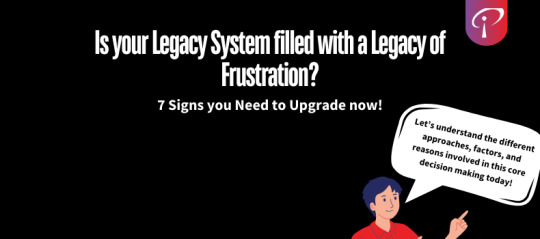
#legacysystemmodernization#legacyapplicationmodernization#legacyappmodernization#legacysoftwaremodernization#legacysystemmodernizationapproaches#legacysystemmigration#legacysystemmodernizationservices#legacysystemmodernisation#itlegacymodernization#legacymodernizationsolutions#whylegacysystemmodernization#iprogrammer solutions#iprogrammer
0 notes
Text
Utilise TechPanda IT's software development expertise to promote efficiency and innovation.
At TechPanda IT Services, we specialize in delivering software solutions that enhance business efficiency and drive innovation. From Legacy System Modernization to Custom Software Development, our team creates flexible, scalable solutions tailored to your needs. We also offer comprehensive Enterprise Software, Custom CRM Development, and Software Product Development services to streamline operations and engage customers more effectively. Plus, our Data Analytics & Information solutions empower you to unlock actionable insights that improve decision-making.
#TechPandaIT #SoftwareDevelopment #EnterpriseSoftware #LegacySystemModernization #CustomSoftware #CRMDevelopment #SoftwareProductDevelopment #DataAnalytics #InnovationInTech #BusinessGrowth
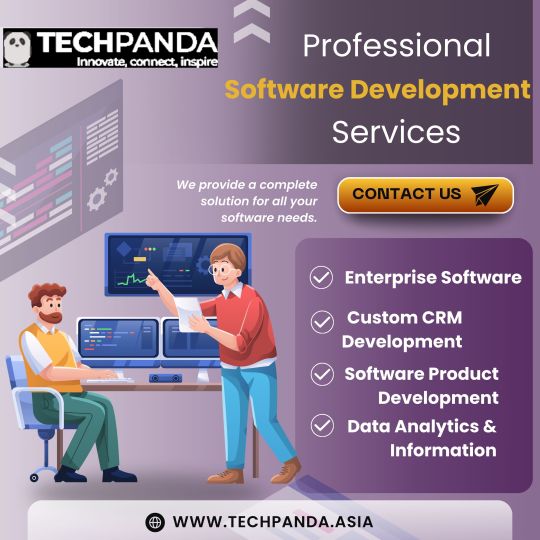
1 note
·
View note